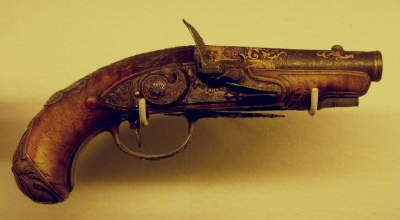
Pirates in the so-called Golden Age of Piracy (1690-1740) used all manner of weapons to attack ships and relieve them of their precious cargoes. Heavy cannons, muskets, pistols, cutlasses, and grenades were just some of the weapons pirates employed to wreak havoc on the High Seas. Besides all of these, perhaps the best pirate weapon of all was the black flag they raised, like a Jolly Roger, or an all-red flag, which meant a vessel should surrender immediately or face dire consequences.
Cannons had a smooth bore in the Golden Age and were fired by ramming an iron ball down the muzzle, pouring gunpowder into a hole in the breach, and lighting it using a slow match (a length of rope which had been chemically treated to burn slowly). Cannons on a pirate ship would have been taken as booty from captured vessels and so they varied in size and power, even on the same ship. The largest cannons might have a barrel up to 12 feet (3.6 m) long and be capable of firing a ball weighing 68 pounds (over 30 kg). However, very few ships had the strength to carry such monsters, and pirates preferred their ships to be fast and sleek. A sloop, the most commonly used vessel type, would have carried only a handful of cannons, and these were usually capable of firing 8- or 12-pound (3.5 or 5.5 kg) cannonballs.
Getting a little closer to an enemy vessel, the next weapon to be employed could be grenades, often called fireballs or powder flasks. These were made from glass bottles filled with gunpowder and a quantity of lead shot or random metal pieces. A slow match like those in guns was put into the neck of the bottle or tied around it so that when arriving at its destination and smashing, flame hit powder and the whole thing exploded. Grenades known as stinkpots might also be filled with substances like sulphur to intoxicate an enemy crew.
Considering some of the drawbacks of gunpowder weapons, it is perhaps not surprising that most pirates favoured the speed and thrust of a sword blade. Thin duelling-type swords were not in use until the 17th century and then only by the nobility. Rather, pirates used a heavy cutlass or sabre which had a sharpened point and a sharp single edge of the blade. These swords were designed to quickly cut and slash an opponent rather than dither about with intricate swordplay. The cutlass had a slightly curved blade, and the hand was well protected by a half-circle guard or cage. The blade could be up to 3 feet (90 cm) in length. As a cutlass blade was thick and heavy, it could be used for other useful tasks such as cutting rigging in an emergency, felling trees, and opening coconuts.
Pirates had several portable gunpowder weapons to choose from which they could use when boarding target vessels. All of them had the disadvantage that they could only fire one shot and then had to be reloaded, which took time that often was not available in the heat of battle. In addition, gunpowder weapons needed dry weather to work best, they were often unreliable and misfired or exploded, and they were not particularly accurate. Some pirates compensated for these defects by carrying several weapons at once, the most famous of these was Edward Teach, aka Blackbeard (d. 1718), who was said to have bristled with six pistols hung from sashes across his torso.
Credit : World History Encyclopedia
Picture Credit : Google



